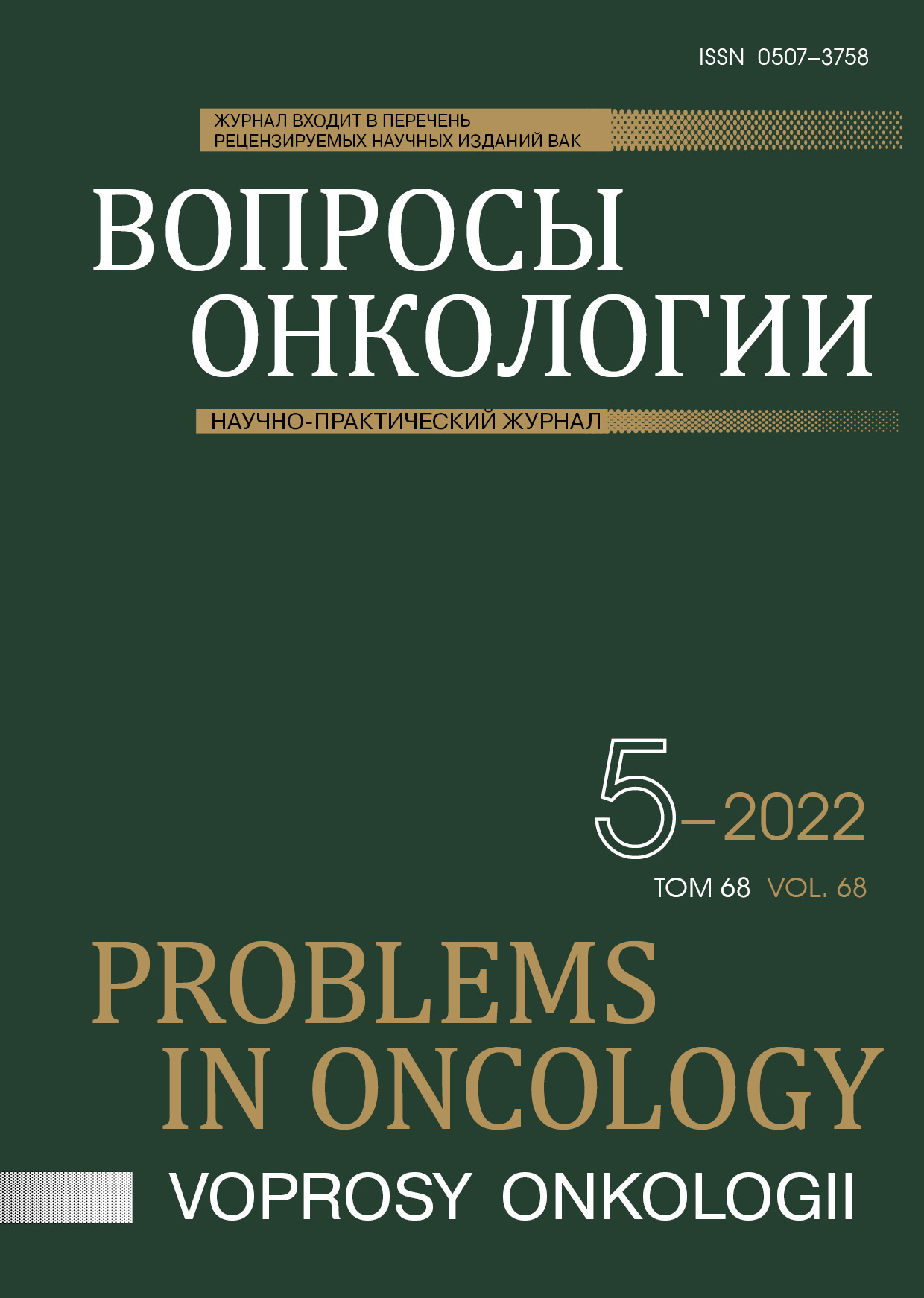Abstract
Introduction. The development of new approaches to screening colorectal cancer (CRC), including those based on such molecular genetic methods as the assessment of microRNA(miRNA) expression, is an urgent clinical task. Purpose of the study. The study was aimed at development of a model for CRC prediction based on the miRNA-21 expression level in saliva and plasma.
Materials and Methods. The miRNA-21 expression levels in plasma (P-miRNA-21) and saliva(S-miRNA-21) samples obtained from 65 patients with diagnosed colon cancer (CRC group) and 66 healthy volunteers were measured by reverse transcription polymerase chain reaction and expressed in conventional expression units (CU). Correlation analysis of the levels of miRNA-21 expression in plasma and saliva with gender, age, localization and stage of the process was performed. Univariate analysis was used to identify CRC predictors. Based on a combination of leading factors, risk classes were formed with the subsequent construction of a decision tree. ROC analysis was used to estimate the quality of the simulated decision tree and the CRR predicting model. The level of statistical significance was fixed at 0.05.
Results. The P-miRNA-21 (3.71±7.38 CU) and S-miRNA-21 (9.67±18.52 CU) in CRC patients was higher than in healthy control (p=0.0089 and p<0.0001, respectively). The sensitivity and specificity of P-miRNA-21>1.6 CU and S-miRNA-21>2 CU as CRC markers were 52% and 89% and 61% and 83%, respectively. No correlation of P-miRNA-21 or S-miRNA-21 with gender, age, process localization and disease stage was found. In univariate analysis the predictors of CRC were: S-miRNA-21>2 CU (Relative risk (CI), RR [CI): 2.51 (1.76; 3.58)], P-miRNA-21>1.6 CU [RR (CI): 2.41 (1.75; 3.31)], age >61 years [RR (CI): 2.65 (1.67; 4.21)], high level of cancer embryonic antigen (CEA) [RR (CI): 2.4 (1.93; 2.99)], high level of СA-19.9 [RR (CI): 2.27 (1.85; 2.78)]. An algorithm for CRC diagnostics was proposed in the form of a decision tree model based on S-miRNA-21, P-miRNA-21 and age, which has high sensitivity (88.7%) and specificity (76.6%) of the model, AuROC 0.86.
Conclusion. Evaluation of the expression miRNA-21 both in saliva and in blood plasma can be suitable non-invasive biomarkers for screening colon cancer, especially as part of the proposed diagnostic model.
References
American Cancer Society. Global Cancer Facts & Figures 3rd Edition, 2015.
Злокачественные заболевания в России в 2014 г. (заболеваемость и смертность) / Под ред. А.Д. Каприна, В.В. Старинского, Г.В. Петровой. М.: МНИОИ им. П.А. Герцена ― филиал ФГБУ «НМИРЦ» МЗ РФ, 2016 [Malignant neoplasms in Russia in 2014 (morbidity and mortality)] / Ed. Kaprin AD, Starinskii VV, Petrova GV. M.: MNIOI im. P.A. Gercena — The MNIOI. P.A. Herzen — branch fgbu «NERC» Ministry of health of Russia, 2016 (In Russ.)].
Verdecchia A, Francisci S, Brenner H et al. Recent cancer survival in Europe: a 2000-02 period analysis of EUROCARE-4 data // Lancet Oncol. 2007;8:784–796. doi:10.1016/S1470-2045(07)70246-2
Ciccolallo L, Capocaccia R, Coleman MP et al. Survival differences between European and US patients with colorectal cancer: role of stage at diagnosis and surgery // Gut. 2005;54:268–273.
Mandel JS, Smith R. Principles of Cancer Screening. Cancer. Principles & Practice of Ocology / Eds. V.T. De Vita, Jr.S. Hellman, S.A. Rosenberg. Philadelphia, Balti-more: Lippincott Williams &Wilcis, 2008:659-676.
Bretthauer M. Colorectal cancer screening // J Intern Med. 2011;270:87–98. doi:10.1111/j.1365-2796.2011.02399
Knudsen AB, Zauber AG, Rutter CM et al. Estimation of Benefits, Burden, and Harms of Colorectal Cancer Screening Strategies: Modeling Study for the US Preventive Services Task Force // JAMA. 2016;315:2595–2609. doi:10.1001/jama.2016.6828
Ransohoff DF, Sox HC. Clinical Practice Guidelines for. Colorectal Cancer Screening: New Recommendations and New Challenges // JAMA. 2016;315:2529–2531.
Tang JT, Fang JY. MicroRNA regulatory network in human colorectal cancer // Mini Rev Med Chem. 2009;9:921-6.
Fukusima Y, Linuma H, Tsukamoto M et al. Clinical significance of microRNA-21 as biomarker in each Dukes’ stage of colorectal cancer // Oncol Rep. 2015;33(2):573-82. doi:10.3892/or.2014.3614
Biscaglia G, Panza A, Gentile A.M et al. Role of microRNA in the pathogenesis of colorectal cancer: possible involvement of miRNA-143 and miRNA-21. Abstracts // Digestive and Liver Disease. 2009;41S:S1–S167.
Mitchell PS, Parkin RK, Kroh EM et al. Circulating microRNAs as stable blood-based markers for cancer detection // Proc. Natl. Acad. Sci. USA. 2008;105(30):10513–10518. doi:10.1073/pnas.0804549105
Xia X, Yang B, Zhai X et al. Prognostic Role of microRNA-21 in Colorectal Cancer [Electronic resource] // Journal Information. Plos One [Official website]. URL:http://journals.plos.org/plosone/article?id=10.1371/journal.pone.0080426 (accessed: 10.05.2015).
Sazanov AA, Kiselyova EV, Zakharenko AA et al. Plasma and saliva miR-21 expression in colorectal cancer patients // J Appl Genet. 2017;58(2):231-237. doi:10.1007/s13353-016-0379-9
Seliverstov RYu et al. Microrna in monitoring of the evolution of glial cerebral tumors // Sib. onkol. ž. 2020;19(3):47–53. doi:10.21294/1814-4861-2020-19-3-47-53
Реброва О. Статистический анализ медицинских данных. Применение пакета прикладных программ STATISTICA. М.: МедиаСфера, 2002 [Rebrova O. Statistical analysis of medical data. Application of the application package STATISTICA. M.: MediaSphere, 2002 (In Russ.)].
Ye M, Ye P, Zhang W et al. Diagnostic values of salivary versus and plasma microRNA-21 for early esophageal cancer // Nan Fang Yi Ke Da Xue Xue Bao. 2014;34(6):885-9.
Stiksma J, Grootendorst DC, van der Linden PW. CA 19-9 as a marker in addition to CEA to monitor colorectal cancer // Clin Colorectal Cancer. 2014;13(4):239-44. doi:10.1016/j.clcc.2014.09.004
Kanaan Z, Rai SN, Eichenberger MR et al. Plasma miR-21: apotential diagnostic marker of colorectal cancer // Ann Surg. 2012;256:544–551.
Wang Y, Gao X, Wei F et al. Diagnostic and prognostic value of circulating miR-21 for cancer: a systematic review and meta-analysis // Gene. 2014;533:389–397.

This work is licensed under a Creative Commons Attribution-NonCommercial-NoDerivatives 4.0 International License.
© АННМО «Вопросы онкологии», Copyright (c) 2022
